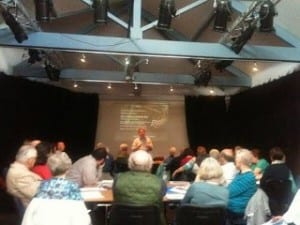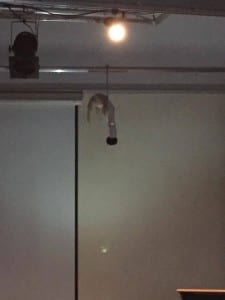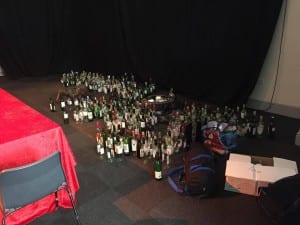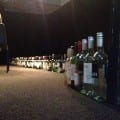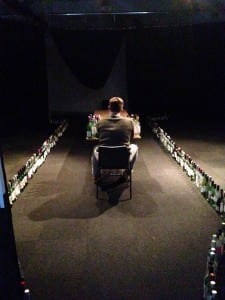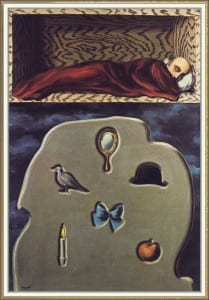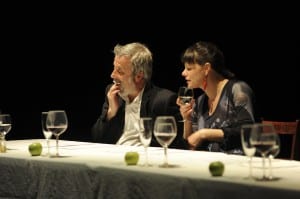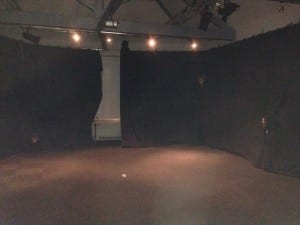Final Blog Post
Framing statement
A drop. A glass. A bottle. “Communion” was a site-specific performance that took place on 4th May 2016 in the “Room Upstairs” at the Lincoln Drill Hall. The piece aimed to connect the audience’s affiliations with drinking and wine to the historical context of the space. Our site was once used as a gentlemen’s club during the Second World War and its connections with post-traumatic stress, alcohol and 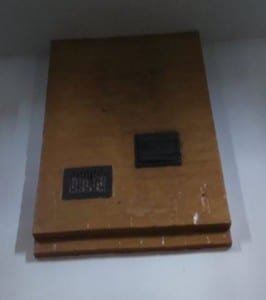 remembrance heavily influenced our piece. The performance consisted of a single audience member being led by the hand into a lift, the audience member was then blindfold and taken up to the room upstairs. The guide would then take the audience into our main installation and the blindfold was removed; the room itself contained a long table with two chairs at its heads; two rows of wine bottles ran parallel to the table and out past it into the second section of the room. I sat at one end of the table and beckoned an audience member to sit and talk with me for a while. We discussed the significance that wine has in their (the audience members) life and its relationship to the history of the space. After a toast the guide led the audience member into the second half of the room in which the second half of our performance began. Another performer began to submerge his hands in dirt from the common; into the dirt he would slowly add crushed grapes and wine until his hands became covered in mud. The performer would then move to the room’s toilet and the guide would suggest that the audience member assist the performer. Once inside the toilet the door would be locked and the performer would instruct the audience member to turn on the taps and wash the dirt of his hands; after these actions were complete the performer would hand over a single chocolate coin and the audience member would be led out by the guide. This performance lasted on average ten minutes and took place from 12:15AM to 5PM as more and more wine was consumed and the concoction of wine and mud became slowly more saturated and disgusting. Our piece aimed to challenge the perceptions of a conventional theatre space. We took the themes of an audience and the consistency of theatre and subverted them; isolating a single audience member within a performance that would feel like a personal message to them. Throughout the performance and creative process we aimed to make the audience forget that our site was a conventional theatre space; this led to a heavy focus on the transformative power of art and how a knowledge of context can change perspectives completely, whilst still utilizing some elements of the rooms current use such as the lighting rig and stage flats to connect the Rooms present state with its past. The piece drew heavy influence from The Last Supper by The Reckless Sleepers, Carl Avery’s Teaching performance studies: 25 instructions for performance in cities as well as Peter Brookes The empty space
remembrance heavily influenced our piece. The performance consisted of a single audience member being led by the hand into a lift, the audience member was then blindfold and taken up to the room upstairs. The guide would then take the audience into our main installation and the blindfold was removed; the room itself contained a long table with two chairs at its heads; two rows of wine bottles ran parallel to the table and out past it into the second section of the room. I sat at one end of the table and beckoned an audience member to sit and talk with me for a while. We discussed the significance that wine has in their (the audience members) life and its relationship to the history of the space. After a toast the guide led the audience member into the second half of the room in which the second half of our performance began. Another performer began to submerge his hands in dirt from the common; into the dirt he would slowly add crushed grapes and wine until his hands became covered in mud. The performer would then move to the room’s toilet and the guide would suggest that the audience member assist the performer. Once inside the toilet the door would be locked and the performer would instruct the audience member to turn on the taps and wash the dirt of his hands; after these actions were complete the performer would hand over a single chocolate coin and the audience member would be led out by the guide. This performance lasted on average ten minutes and took place from 12:15AM to 5PM as more and more wine was consumed and the concoction of wine and mud became slowly more saturated and disgusting. Our piece aimed to challenge the perceptions of a conventional theatre space. We took the themes of an audience and the consistency of theatre and subverted them; isolating a single audience member within a performance that would feel like a personal message to them. Throughout the performance and creative process we aimed to make the audience forget that our site was a conventional theatre space; this led to a heavy focus on the transformative power of art and how a knowledge of context can change perspectives completely, whilst still utilizing some elements of the rooms current use such as the lighting rig and stage flats to connect the Rooms present state with its past. The piece drew heavy influence from The Last Supper by The Reckless Sleepers, Carl Avery’s Teaching performance studies: 25 instructions for performance in cities as well as Peter Brookes The empty space
The room upstairs in use today http://efdss-thefullenglish.blogspot.co.uk/2013/09/lincoln-drill-hall-hosts-first-folk.html
Analysis of Process
From the very first session, the relationship between site specific and space has heavily influenced our devising process; arguably it was the location of the first seminar that sparked this fascination. Studying in an auditorium immediately made us question the contrasts between theatre and performance, we reworked the stage, seating and wings into areas of unconventional performance making our work a part of the building itself; rather than a piece of theatre that exists within the space. The writings of Carl Lavery became a key source of inspiration for us, his article Teaching performance studies: 25 instructions for performing in cities gave us our first insight into what makes site specific performance different from the conventions of theatre we knew. Carl writes “Work can be made out of anything; there is no need for an audience or stage;” (Lavery, 2005, 232-233).
As performers we all have a subconscious relationship with theatre and the stage. Without even knowing we transform ourselves into characters, adopting a new form of presence and speech completely different to that of our everyday lives. Site specific performance aims to change our perspective of what we define performance space as.. Lavery instructs performers that they must “Allow the city to penetrate your senses, your skin” (Lavery, 2005, 5.) This simple instruction puts the relationship of actor and space into a completely new perspective. As an actor my relationship with the space in which we create theatre has always been a platform to create work rather than another element in that process, a stage has always been a platform to walk across and a theatre just a building to perform inside of. Beginning to explore site specific performance has changed this perspective completely. Lavery’s article tells us that we must look at space not as something to perform on or around but as another tool in our artistic arsenal.
This attitude towards performance space seems highly appropriate to the Drill Hall; At first the idea of creating site specific inside of a working theater seemed rather contradictory as it seemed the whole purposes of this style of theater was to allow us to experience drama away from the conventions of the stage and theater. However with a building so rich in both personal and cultural history, developing a strong relationship with the space is vital to capturing its character in our work. The room upstairs is a perfect example of an actor’s relationship with space; instantly we were drawn towards the large black box performance space rather than the conference room adjacent to the performance area. The space adjacent to the black box appeared to be a much more interesting space to create sit specific performance around. Its previous history as a gentlemen’s club and its current use as a children’s play group provides an interesting juxtaposition to create performance around.
Initially we decided to combine the Room upstairs history through an art installation that combined the aesthetics of a children’s play group and a gentle men’s club; tables would be decorated with stuffed toys and sweets with ash trays and whisky bottles littered around. The audience would be offered milk in wine glasses and ask to sample meals that had been blended into baby food. In order to address the problems a theatre space would present we planned on highlight the presence of the lighting rig by suspended wine glasses and dolls on string at varied levels (representing those that fell in the war) However as we continued experimenting with this juxtaposition we noticed that the complexity of the aesthetic drew away from the personality of the building and decided keeping the wine bottles as the key aesthetic within our piece and removing the elements of the children’s playgroup as the information seemed forced. This deconstruction also effected how we presented the information about the men’s club, originally we planned to decorate the walls with children’s drawing that depicted the events within the letters of a Major Newsum we studied at the archives. However we didn’t want to simply present information to an audience in a conventional way. Performance should be about interpretation, an audience does not want all the answers presented to them; they want to explore performance and create their own interpretations; at this point in the creative process, communion began to take shape.
We decided that the best way to get our audience thinking about the historical relevance of the site to our aesthetic of wine was through subtle references and observations. It was also at this point we began to look at the work of the reckless sleepers as in influence to our performance; in particular their piece The Last Supper in which audience members are invited to drink and eat as performers share the last words of famous and infamous people from history. The sleepers approach to performance comes from a place outside the conventions of theatre “They are constructed layers of out and pasted sets of fragments that have been worked out in front of a computer screen, in a black box, on a train journey home, in the middle of the night.” (Wetherell, 2016) this inspired us to branch out and explore the unseen spaces of the room upstairs; we included the bathroom as a part of our performance due to its connections with solidarity. The act of entering a toilet with a performer and hiding your actions seemed one that could be very effective.
The Routledge guide to theatre and performance indicates that “Performance art was and is concerned with identity” (Allain and Harvie,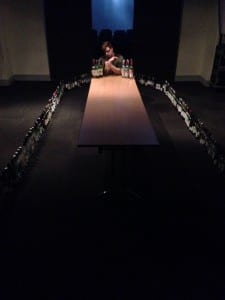 2009, 183) this idea of personal identity went on to inspire the way in which I would interact with the audience as a performer. I would not play a character from the gentlemen’s club but would act as a universal timeless host; giving brief insight into the sites history but also connecting it to the audience through their personal relationship with wine. (Wines personal relationship to the performance is explored further in my previous blog post “Then fill my glass, fill it high,” (Purcell, 1659) Wines sensory impact on performance and rehearsal available at: https://sitespecific2016mpi.blogs.lincoln.ac.uk/2016/04/11/rituals/ )
2009, 183) this idea of personal identity went on to inspire the way in which I would interact with the audience as a performer. I would not play a character from the gentlemen’s club but would act as a universal timeless host; giving brief insight into the sites history but also connecting it to the audience through their personal relationship with wine. (Wines personal relationship to the performance is explored further in my previous blog post “Then fill my glass, fill it high,” (Purcell, 1659) Wines sensory impact on performance and rehearsal available at: https://sitespecific2016mpi.blogs.lincoln.ac.uk/2016/04/11/rituals/ )
My dialogue was to be vague but engaging, it required the audience to draw on their own experiences with alcohol and remembrance but also to question the actions of the men’s club and the soldiers that drank there. By simply giving clues to the audience about the existence of the men’s club (hinting at the chimney stack stained with nicotine for example) was designed to intrigue the audience leading them to question the visual stimulation in the second half of our performance.
We still wanted to draw attention to the rooms lighting rig, designing a lighting state that put a focus on the table and two chairs whilst masking the black treads and walls of the theatre space. This was done to create an uneasy feel for the audience as the visuals disguise the room’s original aesthetic but do not remove it completely; making it unclear as to where the line between the past and present starts or stops.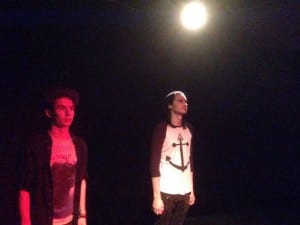
We also decided to create a big disconnect from the striking image of the wine bottles in the first half of our piece, by approaching the second half of our piece with a very simplistic approach. A single table was laid out with a trail of wine bottles guiding the audience member to a seat. We wanted the second half of our performance to contain a certain unsure nature, Jacobs actions had no specific time period and the results of his win, grape and dirt concoction became more severe with each audience member, against this was one of the ways we aimed to break the convention of theatrical repetition and replication; an idea taken from the idea of Happening and Peter Brooke’s praise from them in the empty space believing such spontaneity “destroys in one blow many deadly forms, like the dreariness of theatre buildings, and the charmless trappings of curtain” (Brooke, 1968, 61). This unpredictable part of our piece helped to make the performance even more personal, as each individual audience member would experience Jacobs’s performance at a different stage; witnessing him struggle more and more with the mixture as it become wine-logged and messy.
The final aspect of our performance was arguably the most intrusive and personal section. As the audience was guided into the toilet they became separated from the guide (who had been subtly in contact with them for the entire piece) and locked in a small darkened cubicle with a grown man struggling to wash his hands. We chose this highly intimate and personal space to create an uncomfortable atmosphere and a sense of disconcertion; as the transaction of a single gold coin behind a locked bathroom door was our final way of hinting that the men’s clubs secretive operations will remain a mystery to the present as we continue on their memory through “that secret ritual, an unspoken communion” (Shiel,2016).
Performance evaluation
Despite our original aim to fill the room upstairs with wine bottles, our final count of 600 bottles was not enough to fill the space completely (something made possible by the generous donations of local restaurants and bars; most notably William V and Harvester along the Brayford quay who provided us with a majority of the bottles we needed). However when setting up we noticed the placement of bottles naturally formed began to create the outline of a wine bottle tapering into a bottle keck as the installation finished. This seemed as effective as filling the room and creating some beautiful shadows across the table creating even more mystery.
(Anthony and Kay, recorded 22nd April 2016)
Despite get in overrunning by 15 minutes the performance was a success. Each 15 minute slot was filled with a varied audience member each time. From parents to local war veterans, each audience member explored their relationship with wine in a very different way. Some chose to answer the rhetorical questions I put forward. Some drank before I even raised my own glass. It was also interesting to examine who joined me for the toast as the younger audience members simply drank whilst the older ones returned my words back.
I found that during the course of the performance (and three bottles of wine) I started to view the liquid in a different way. Its smell and taste changed drastically and I slowly began to realise what the consumption of alcohol means to me; almost as an unofficial audience member to my own performance.
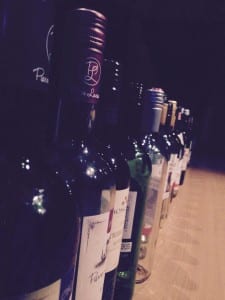 My biggest problem with the piece was one lighting problem. Originally I had planned to highlight the stained chimney stack with a profile as this would have created a great sense of depth for the audience member’s initial viewing. Unfortunately the room is set out so a large support beam blocked the stack from all light. This profile instead highlighted the area in which Jacob performed his task; with the pale light disconnecting him from the darkened space.
My biggest problem with the piece was one lighting problem. Originally I had planned to highlight the stained chimney stack with a profile as this would have created a great sense of depth for the audience member’s initial viewing. Unfortunately the room is set out so a large support beam blocked the stack from all light. This profile instead highlighted the area in which Jacob performed his task; with the pale light disconnecting him from the darkened space.
Speaking to audience afterwards, the perception was very positive. The striking visuals and immersive atmosphere really drew in your senses and the sheer scale of the wine bottles was “mesmerising”
As an actor brought up on the conventions of the stage. I was at first apprehensive of the world of site specific performance art. However it has opened my eyes to a side of drama that is not only striking and vibrant but also intellectually stimulating. Challenging my relationship with space and my attitude towards how the place a performance takes place has a strong connection to the work itself.
Bibliography
Allain, P. and Harvie, J. (2006) The Routledge Companion to Theatre and Performance. Abingdon: Routledge.
Brooke, P. (1968) The Empty Space. St Ives: Penguin books
Lavery, C. (2005) teaching performance studies: 25 instructions for performing in cities. Studies in Theatre and Performance, 25 (3)229-238.
Shiel, J. (2016) Communion. [Performance art] Lincoln, UK: Lincoln Drill Hall, 4 May.
Roud, S. (2013) at the room upstairs. [online] Available from: http://efdss-thefullenglish.blogspot.co.uk/2013/09/lincoln-drill-hall-hosts-first-folk.html [accessed 13 May 2016].
Wetherell, M. (2016). Reckless Sleepers. [online] Reckless Sleepers. Available at: http://www.reckless-sleepers.eu/#!statement/czjr [Accessed 13 May 2016].

